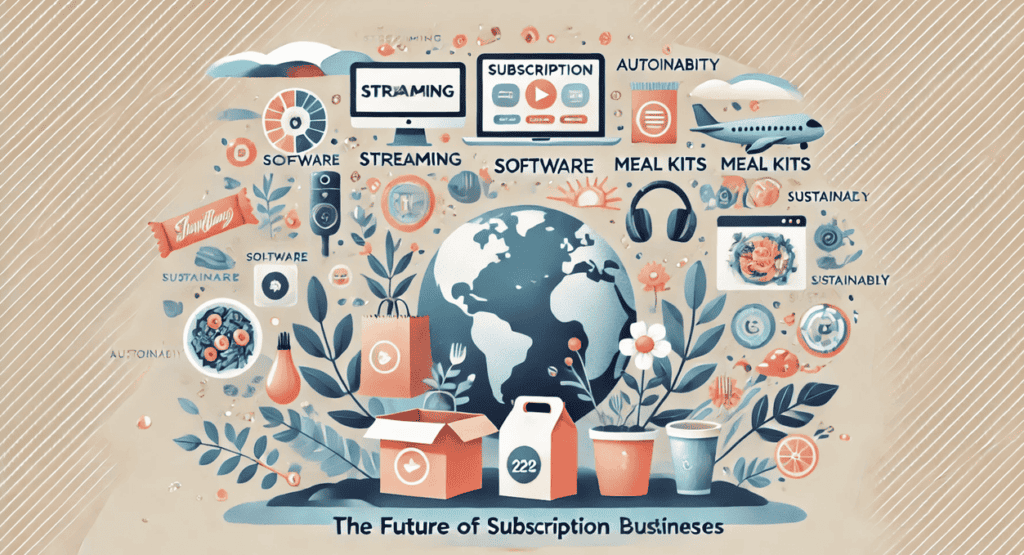The future of subscription businesses
The future belongs to subscription businesses. Consumers demand flexibility, personalization, and convenience—while companies seek stable revenue and customer loyalty. But how can your business unlock the full potential of the subscription model? Read on to explore upcoming trends, common challenges, and how automation can ensure success for your subscription-based business.

The future of subscription businesses
The subscription model, where customers continuously pay for a product or service, has rapidly gained popularity. From streaming services and software to meal kits and toothbrushes—consumers subscribe to almost everything. For businesses, this subscription model provides predictable recurring revenue and deeper customer relationships, making subscription businesses one of tomorrow’s dominant business models.
Why has the subscription model become so popular?
Consumers love the convenience of subscriptions: no large upfront payments, regular updates or deliveries, and easy adjustments or cancellations. Companies benefit from sustained customer relationships and more stable revenue streams. Think Netflix or Spotify, which revolutionized their industries through subscriptions. The model creates a win-win scenario, offering continuous access to updated content or products, while businesses build loyalty.
Subscriptions align well with modern consumer habits. Many now prefer access over ownership—why buy when you can subscribe and always have the latest? This shift in mindset, combined with digitalization, has set the stage for subscription businesses to thrive.
Growth in the subscription economy—globally and locally
The global subscription economy has experienced explosive growth, increasing by over 435% in just nine years. According to UBS, it’s projected to reach approximately $1.5 trillion USD by 2025—more than double its estimated value from a few years ago. Subscription businesses aren’t just trendy; they’re a significant, growing segment of the global economy.
In Denmark, this subscription boom is also clear. A recent Scandinavian study from 2024 showed the average Danish household now holds around 20 subscriptions, up from 17 in 2020. These include streaming, mobile subscriptions, meal boxes, and memberships, costing an average household around DKK 6,500 monthly—approximately DKK 78,000 annually. This totals an impressive DKK 218 billion per year across Danish households alone. Furthermore, nearly half of Scandinavian consumers expect to subscribe to even more products and services in the future, indicating continued growth.
Consumer trends: flexibility, personalization, and user-friendliness

Understanding modern consumers’ expectations is key to grasping the future of subscription businesses. Customers primarily demand flexibility—easy subscription sign-ups, adjustments, and cancellations without hassle. No one appreciates long-term commitments or complicated cancellation processes.
Additionally, consumers seek personalized experiences tailored to their preferences, such as customized product deliveries or recommendations based on their tastes. Technology allows businesses to collect data, learn customer preferences, and deliver precisely what they desire.
Lastly, user-friendliness is essential. From sign-up to everyday use, a frictionless experience is critical. Poor website or app experiences can easily drive customers away. Consumers value excellent customer service, quick support, clear communication, and loyalty rewards—factors critical to retaining subscription customers.
The above are three key factors every subscription business should consider having in their arsenal.
Future trends: AI, automation, and sustainability
Several exciting trends are shaping the future of subscription businesses:
- AI and machine learning: AI helps analyze customer behavior, predicting preferences and enabling hyper-personalization. It can also forecast churn, allowing proactive retention measures.
- Increased automation: Automation will dominate subscription business operations, handling billing, renewals, payment reminders, and customer interactions, reducing human errors and operational costs.
- Focus on sustainability: Subscription models naturally support sustainable consumption through sharing and reuse. Companies will increasingly leverage sustainability, offering green initiatives and eco-friendly products.
- Innovative Business Models: Subscription thinking spreads to unconventional industries, such as cars or everyday consumer goods, introducing hybrid models combining subscriptions with pay-per-use or exclusive memberships.
Challenges: customer retention and payment handling
Subscription businesses also face challenges, notably churn—losing subscribers. Acquiring new subscribers is costly, making retention crucial. Reasons for churn include insufficient perceived value or better offers elsewhere, with price sensitivity heightened during uncertain economic times. Companies must focus on delivering consistent value, engaging communication, gathering feedback, and providing flexibility or loyalty benefits.
Payment handling is another challenge. Managing payments for numerous subscribers can become overwhelming, with billing errors or payment delays affecting revenue and trust. Issues like expired cards, failed transactions, or multiple payment methods require robust solutions. Customers expect seamless payment processes with minimal disruptions.
Automating subscriptions with Alunta
Fortunately, technology platforms like Alunta help resolve these challenges. Alunta automates subscription management, removing manual payment follow-ups or invoice generation. Payments and invoicing occur automatically and timely, significantly reducing errors.
With Alunta, businesses spend less time on administrative tasks and more on customer service and product development. It manages customer accounts, recurring payments, receipt issuance, and payment reminders, providing clear insights into subscriber data, revenue, and churn. Such platforms simplify complex subscription management, even for smaller businesses.
Conclusion: Embracing the subscription model
Subscription businesses are here to stay, expected to grow even further. Companies should consider how subscriptions might enhance their strategic planning. Whether offering software, physical goods, or services, subscriptions can bring stable income and stronger customer relationships.
The future is bright for subscription businesses, but success requires customer-centric approaches, appropriate technologies, and adaptability to evolving trends. Businesses investing in exceptional customer experiences, flexibility, and effective subscription management tools will hold significant competitive advantages.
Now is the ideal time to integrate subscription models into your business strategy. With the right approach, subscriptions can drive growth, customer loyalty, and a more predictable, successful future for your company.